Kigali International Peace Marathon. 8th June 2025.
We conquered a few of the thousand hills of Rwanda during the 10k of the “Race for Peace” in the Kigali International Peace Marathon. A fast-growing event with a challenging course with stunning views over the city.
TLDR; “too long, didn’t read”
- I just want to run! Take me to RACE.
- I have 1 minute. Take me to USEFUL INFORMATION.
- Running is my excuse for travelling. Take me to TRIP.
- Running is my excuse for eating. Take me to CARBOLOADING.
- I want to know what to read in the plane. Take me to ONE BOOK.
🌍 The trip 📷: What to see in Rwanda in a week
🇷🇼 Reflections from Rwanda
For my generation, Rwanda is etched in memory through the lens of the 1994 Rwandan genocide —a time when bands of Hutus with machetes slaughtered their Tutsi neighbors. A time of unimaginable horror. 🕯️
Back then, TV was our only window into the world. We watched in disbelief as the horror unfolded—those grainy images still etched in my mind.
So this trip… it was more than just travel. It was personal, reflective and emotional.
I wanted to walk the land I had only seen on television as a young adult. And Rwanda did not disappoint. 🌍✨
I wrote most of these lines from Volcanoes National Park, as heavy tropical rain lashed against the tin roof of our lodge. The ceiling trembled. The sound of the downpour echoed through the forest. I felt it—I was really here.
🌧️ Outside, African nature revealed its force—wild, lush, and unbothered by our presence.
I’ll never forget what I saw:
👧🏽👦🏽👧🏽 Three little students in uniform sprinting under the rain…
☂️ A woman with a vibrant umbrella striding gracefully beside them…
🌾 Farmers tending their emerald-green fields in the shadow of misty volcanoes, unshaken by the storm.
🛣️ Crossing from Uganda
We entered Rwanda by land from Uganda, on a rainy afternoon in June. Trucks, bicycles, and baskets of goods created a colorful chaos at the border 😄
To our surprise, everything was smooth.
✅ No bribes.
✅ No tension.
And for the first time, we saw Exit and Entry counters from two different countries… in the same building.
This journey will stay with me forever 💚
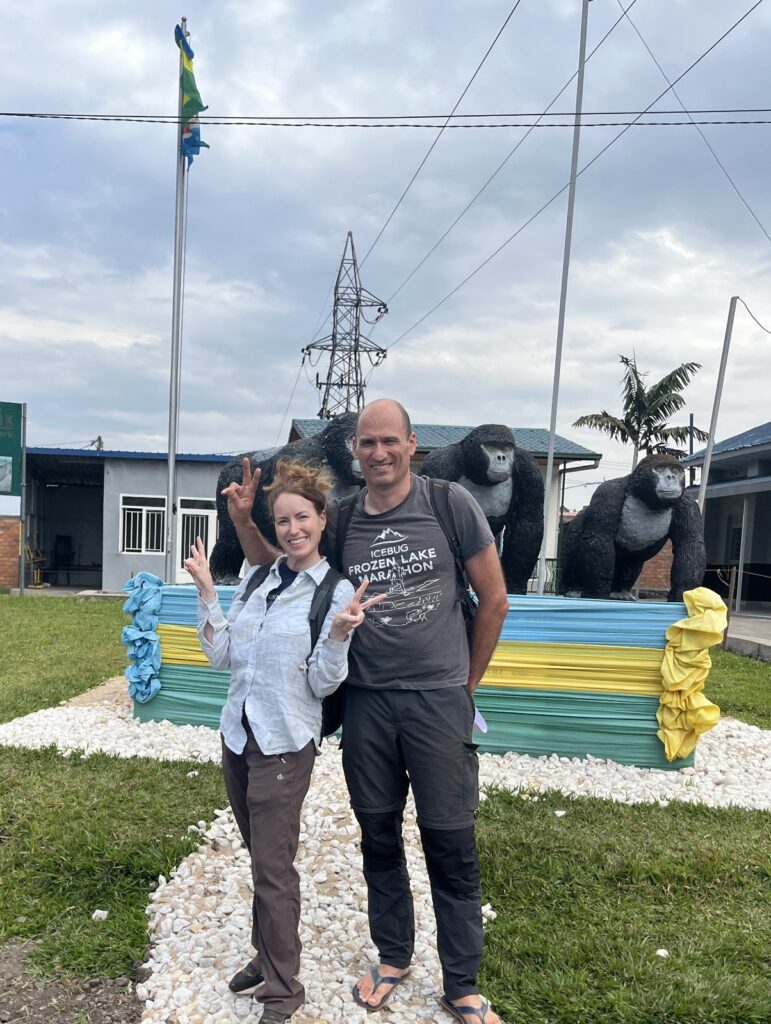
🎉 Smooth Arrival & First Impressions
We crossed the border without much hassle—and even had time for a few fun photos 📸 next to a sculpture of three gorillas painted in the vibrant colours of the Rwandan flag 🇷🇼. A perfect welcome!
🌍 First Impressions & Fascinating Facts
The differences with Uganda appeared almost immediately.
🛵 Mototaxis all wore helmets—yes, both the drivers and passengers! ✅ Leticia, our guide, explained it’s the law in Rwanda.
Later, I even came across a story about a Rwandan startup rolling out electric bikes. Innovation meets regulation. ⚡🚴♂️
👗 Culturally, Rwanda also felt distinct. I noticed how many women wore traditional clothing—but with a twist:
Their dresses featured bold patterns, sharp geometric designs, and vibrant colours that practically danced under the grey sky.
It was one of those moments where you realize: you’ve entered a different country, yes—but also a different rhythm of life. 🌀💫
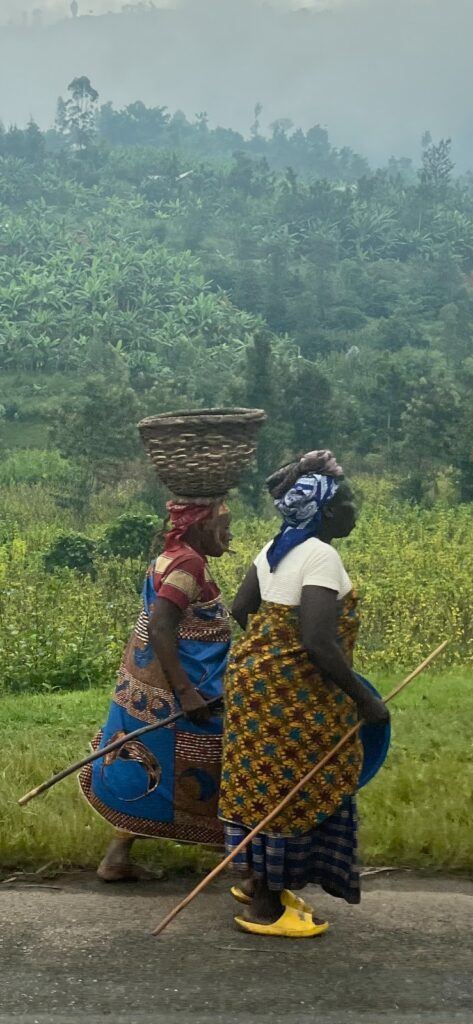
😂 A Quick Google Lesson: The Umushanana!
Curious about the beautiful traditional dresses, I looked it up later—and here’s what I found!
In Rwanda, the iconic women’s attire is called the “umushanana”.
It’s a long, flowing fabric wrapped elegantly around the waist over a skirt, then draped gracefully over one shoulder—usually paired with a matching blouse. So graceful! 👗✨
In contrast, Uganda’s traditional dress for women is the “gomesi”—a bright, colorful gown with a square neckline, puffed sleeves, and a sash tied around the waist. Both are stunning, but totally different vibes! 🌈👚
🌳 Tree-Lined Roads & Unexpected Vibes
I was pleasantly surprised when we entered Rwanda—roads lined with tall, stately trees planted by hand, creating avenues that reminded me of European streets with perfect shade.
“It might be the French influence,” our guide Roger mused.
Funny enough, Rwanda was actually a Belgian colony, not French… 🤔
📜 History Snapshot: A Turbulent Century
Rwanda’s recent history has been deeply shaped by its colonial past. After World War I, Belgium took control from Germany and ruled Rwanda.
Under Belgian administration, ethnic divisions between the Hutu majority and Tutsi minority were intensified—they introduced ID cards and gave preferential treatment to Tutsis in education and politics. This institutionalized inequality brewed resentment.
By independence in 1962, the Hutu majority gained power and reversed these dynamics, leading to decades of ethnic tensions, violence, and displacement of Tutsis

⚠️ A Dark Chapter: The 1994 Rwandan Genocide
The historic divisions we talked about reached a catastrophic peak in 1994. Over approximately 100 days, Rwanda endured one of the most horrific genocides in modern history.
After the assassination of President Juvénal Habyarimana, extremist Hutu forces launched a brutal, systematic campaign to exterminate the Tutsi population—and moderate Hutus caught in between.
The death toll? Between 800,000 and 1 million lives lost. 😔
The international community largely failed to intervene in time, and the country was left shattered—physically, emotionally, and socially.
✊ A Nation Rebuilt
The genocide ended when the Rwandan Patriotic Front (RPF), led by Paul Kagame, took control and stopped the violence.
The new government focused on rebuilding Rwanda through:
🔹 Reconciliation
🔹 Justice (notably through the traditional Gacaca courts)
🔹 Social unity
Since then, Rwanda has made incredible strides in economic growth, healthcare, and education—while maintaining a strong commitment to healing as a nation.
🕯️ Remembering to Never Forget
The legacy of 1994 remains deeply woven into Rwanda’s identity. Memorials and national remembrance ceremonies play a vital role in honoring the victims and ensuring the horrors are never repeated.
Rwanda’s story is one of pain—but also of resilience, hope, and remarkable transformation.
The Volcanoes National Park
We stayed in the cozy Le Bambou Gorilla Lodge: in fact, I wrote some of this post in front of the fire, with a hot ginger tea.
The lodge, as its web indicates, is extremely close to the Volcanoes National Park.
Volcanoes National Park in Rwanda is a breathtakingly beautiful sanctuary nestled in the Virunga Mountains, home to five towering volcanic peaks, including Mount Karisimbi, the tallest at 4,507 meters (14,787 feet).
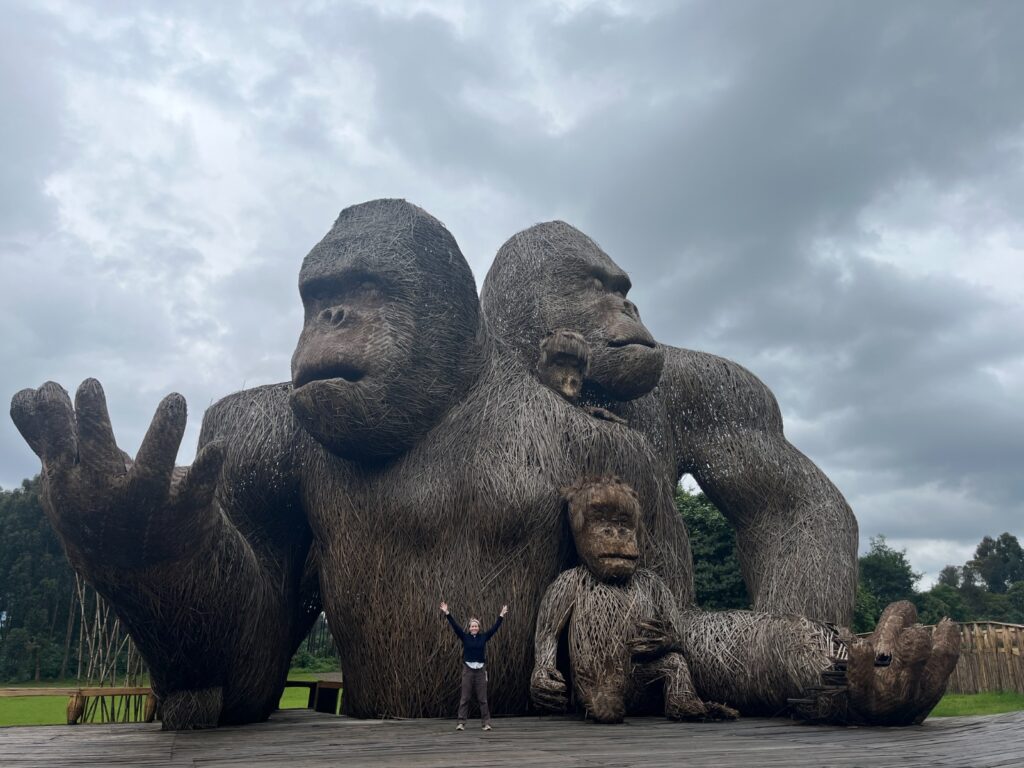
🌿 Volcanoes National Park: A Wildlife Sanctuary Like No Other
This park is world-famous for its endangered mountain gorillas, made iconic by the legendary Dian Fossey’s research. It offers one of the most intimate and awe-inspiring wildlife encounters you can imagine. 🦍✨
Trekking through its misty slopes, dense bamboo forests, and rugged volcanic terrain was beyond words—it wasn’t just a physical journey, but a deeply emotional one.
Volcanoes National Park truly is a haven for these endangered mountain gorillas.
🐒 Our Gorilla Encounter & The Golden Monkeys
We had already been lucky to meet the gorillas in Uganda. This time, our goal was to visit another rare treasure of the park—the Golden Monkeys.
These stunning primates are a rare and endangered species found mainly in the Virunga Mountains within Volcanoes National Park. Their vibrant golden fur makes them unforgettable! 🌟🐒
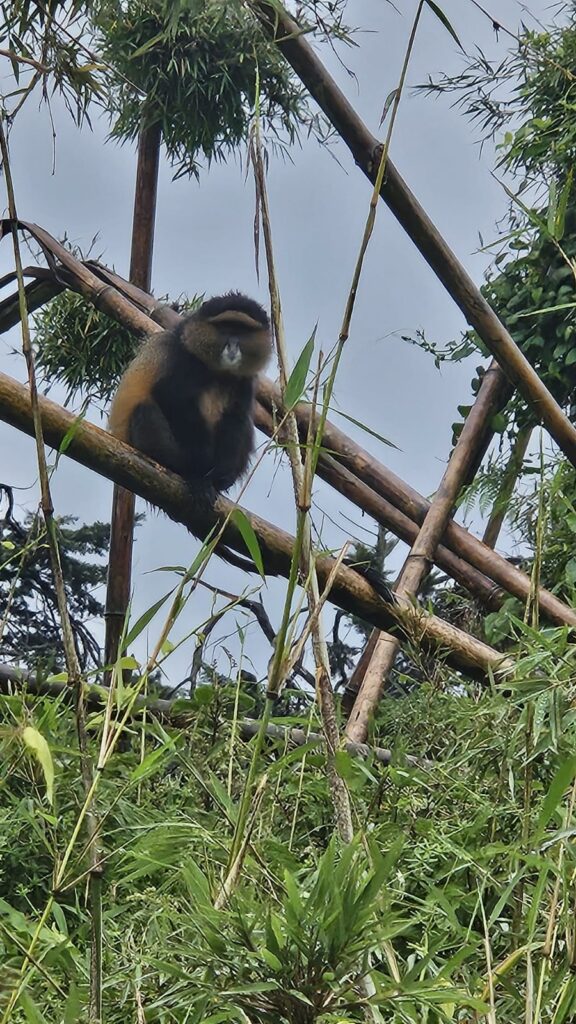
🌟 The Golden Monkeys: Rwanda’s Shining Gems
Known for their striking golden-orange fur and playful personalities, these monkeys live high up in bamboo forests and travel in large, tight-knit social groups. 🐒🍂
They’re a unique subspecies of the blue monkey—endemic to this region—which means Rwanda is one of the very few places on Earth where you can see them in their natural habitat. 🌍💛
🌿 Conservation in Action
Thanks to dedicated conservation efforts—like eco-tourism and habitat protection—the Golden Monkeys’ population is slowly recovering.
Visitors get the incredible opportunity to witness these beautiful creatures and support local communities and environmental sustainability at the same time. Win-win! 🌱🤝
🦶 How the Experience Works
Just like our chimps or the gorilla walks in Uganda, there are strict rules to follow to protect these animals and their habitat.
And I’m happy to say that all tourists were respectful and obedient—no ‘rogue’ tourists on our trips! 👍🙏
Very similar to the we did in Uganda, there are strict rules which need to be observed.
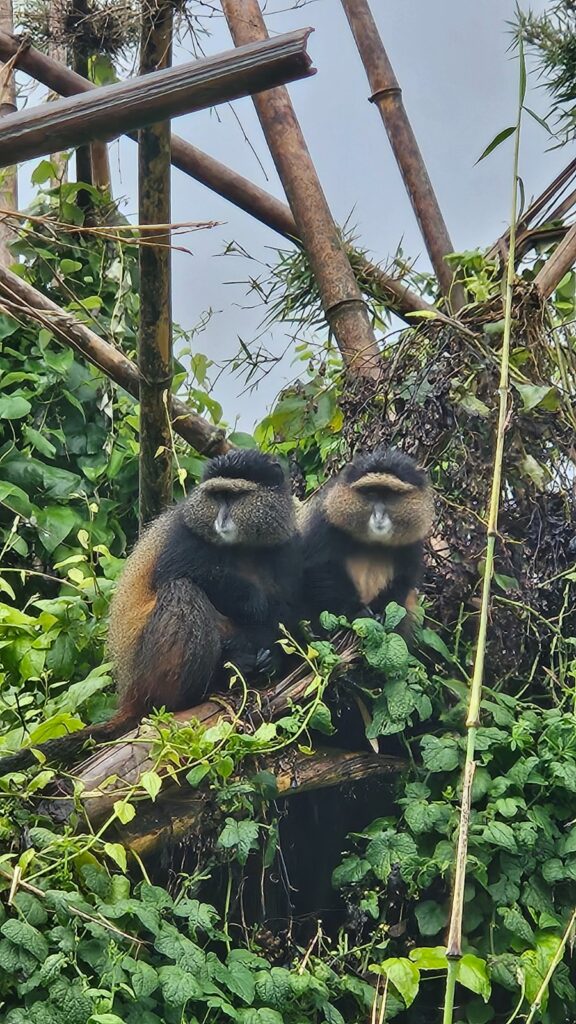
😷 Rules of Engagement: Respect & Safety First
To protect the monkeys and ourselves, we had to wear masks 😷 and were allowed only one hour with the Golden Monkeys.
Touching them? Absolutely forbidden.
Interestingly, you can’t use flash photography with gorillas—it annoys them—but with the monkeys, it’s allowed!
“They don’t mind,” our ranger reassured us. 📸✨
🌧️ The Trek: Mud, Rain & Running Shoes!
The trek wasn’t so much tough because of the terrain, but because of the rain and mud.
Picture this: we wore running shoes 😱 while the rangers sported rain boots and other tourists had fancy trekking shoes. Not ideal!
After about 30 minutes of slippery hiking, we finally reached the family of Golden Monkeys.
There they were—golden fur gleaming as they jumped and nibbled on bamboo.
After seeing chimps and gorillas, these petite, playful monkeys felt almost cute by comparison! 🐒💛
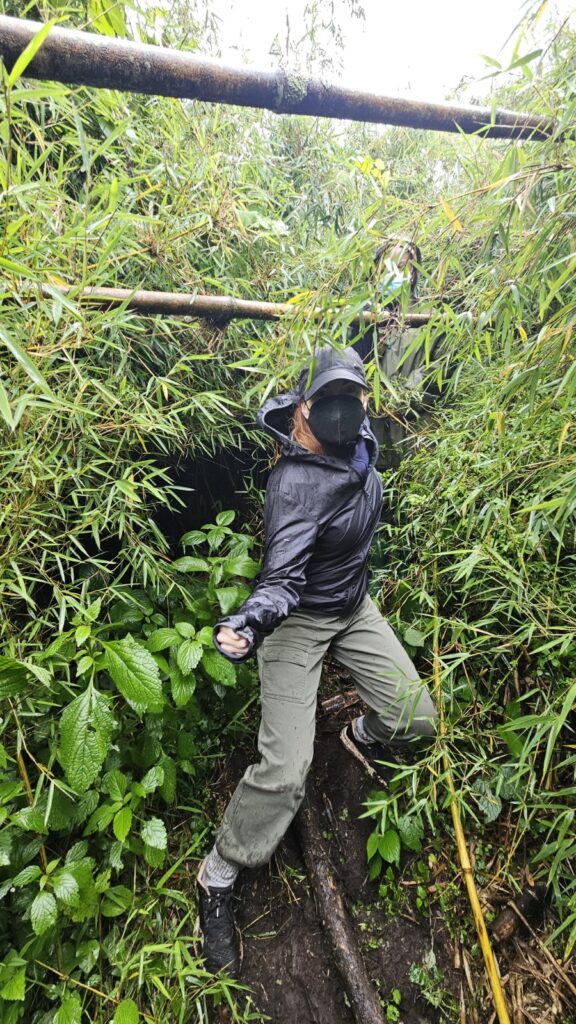
🌿 Deeper Into the Forest
We pushed on through very dense vegetation—the trek got a bit trickier—but it was worth it.
We came across more Golden Monkeys, including a large male who nonchalantly munched just a few feet away. This gave us the perfect chance to snap some amazing photos! 📸🦍
By the end, we were absolutely soaked and covered in mud—but totally exhilarated.
Trekking deep into the heart of the African tropical forest to see Golden Monkeys—how cool is that?! 🌧️🐒💚
🏨 Special Stay: Hotel des Mille Collines
I still remember watching Hotel Rwanda when it came out in 2004. The impact it had on me was unforgettable.
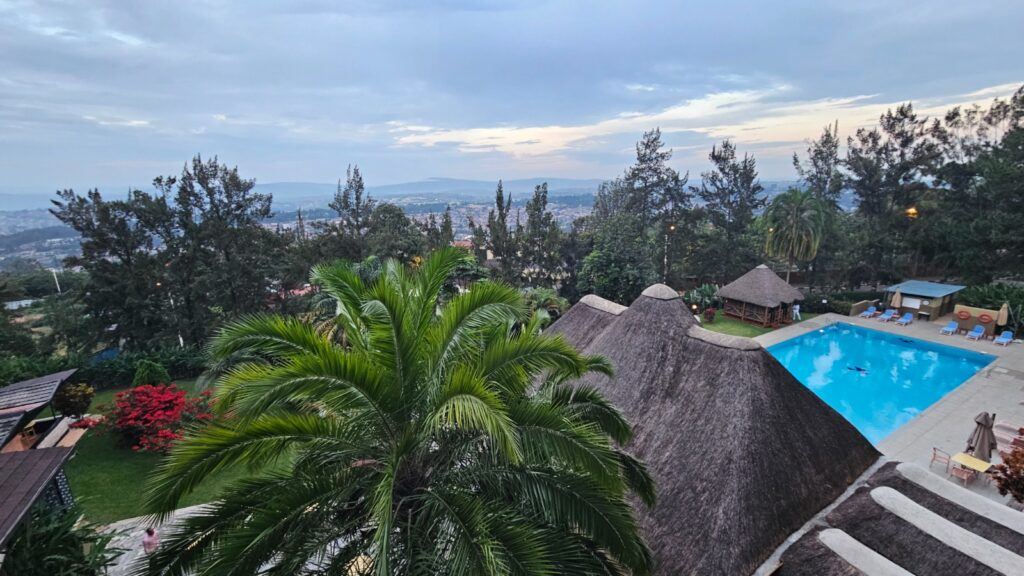
🎬 Hotel Rwanda: A Powerful…True? Story
Hotel Rwanda is a 2004 historical drama based on the incredible true story of Paul Rusesabagina, a hotel manager who courageously sheltered over 1,200 refugees during the 1994 Rwandan Genocide.
Set in Kigali’s Hôtel des Mille Collines, the film shows how Paul used his connections, diplomacy, and bravery to protect Tutsis and moderate Hutus from massacre—while much of the international community sadly stood by. 😔
Directed by Terry George and starring a brilliant Don Cheadle, Hotel Rwanda brought global attention to the genocide’s horrors and sparked important conversations about humanitarian intervention, media responsibility, and personal courage in crisis.
📰 Recent Controversy
However, the film’s portrayal of Rusesabagina has been met with criticism. Some survivors and experts argue that it misrepresents events, suggesting Rusesabagina’s role was exaggerated. Furthermore, Rusesabagina’s later political activities and subsequent arrest on terrorism-related charges have added complexity to his legacy.
🏨 The Hotel Still Stands
When I learned that Hôtel des Mille Collines is still operating today, I decided to splurge a little and book ourselves a couple of nights there—an unforgettable experience with deep meaning for our trip.
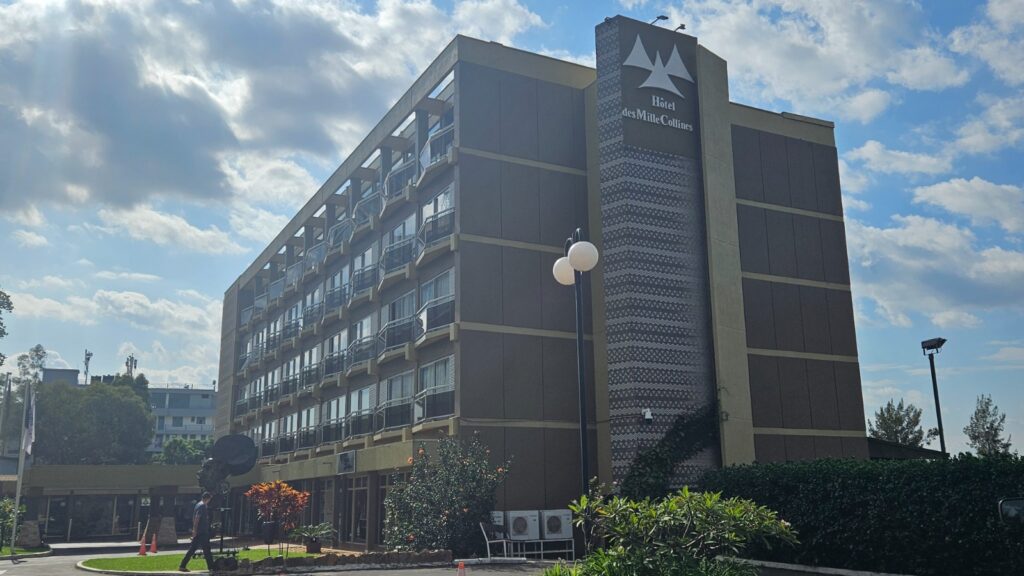
The Hôtel des Mille Collines has since largely distanced itself from the events portrayed in Hotel Rwanda.
Now managed by a completely different company than during the genocide, the hotel has been fully renovated and operates as a modern, upscale destination welcoming both business travelers and tourists. ✨
I absolutely loved the passion fruit and dry tomato cocktail they served us upon arrival—such a refreshing welcome! 🍹
While the hotel remains a powerful symbol because of its history, the current management focuses on a future-facing vision, prioritizing hospitality and comfort over the past. 🌟
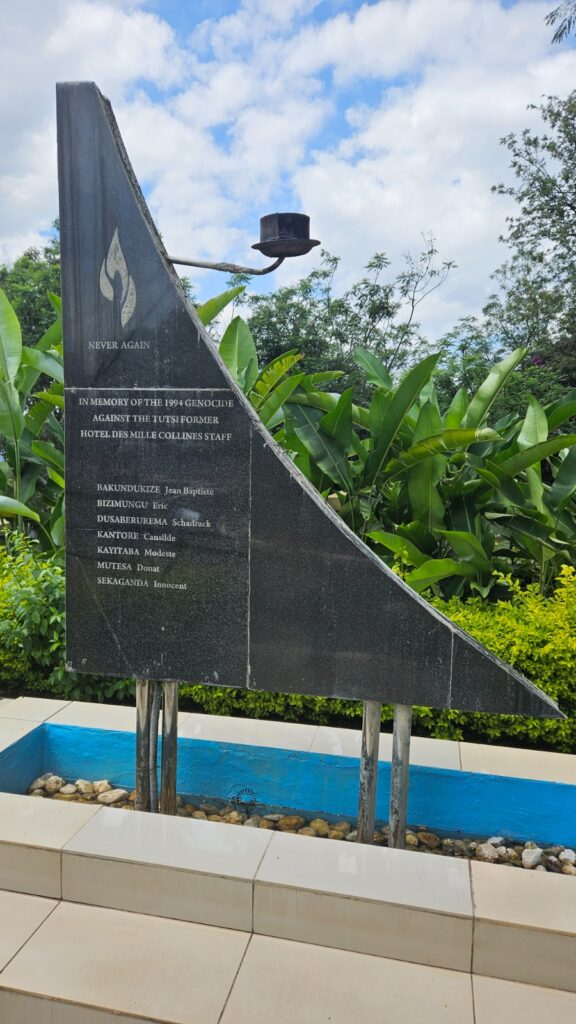
🇷🇼 The Rwandan government and some survivors have criticized certain aspects of the film’s portrayal and Paul Rusesabagina’s legacy, making the hotel’s history a mix of remembrance and controversy. Despite this, the Hôtel des Mille Collines remains a key landmark for visitors wanting to understand Rwanda’s journey through tragedy and recovery.
🚖 Fun (and intense) fact: When we got into our taxi, it was thoroughly checked. A well-dressed security guy even used a UVSS — an Under-Vehicle Scanning System! It honestly felt like we were entering a war zone! 😳🔍
🕊️ Kigali Genocide Memorial
After our Run for Peace, we walked the 3.7 km from the Hôtel des Mille Collines to the Kigali Genocide Memorial—a deeply moving place that brings Rwanda’s history and resilience into sharp focus.
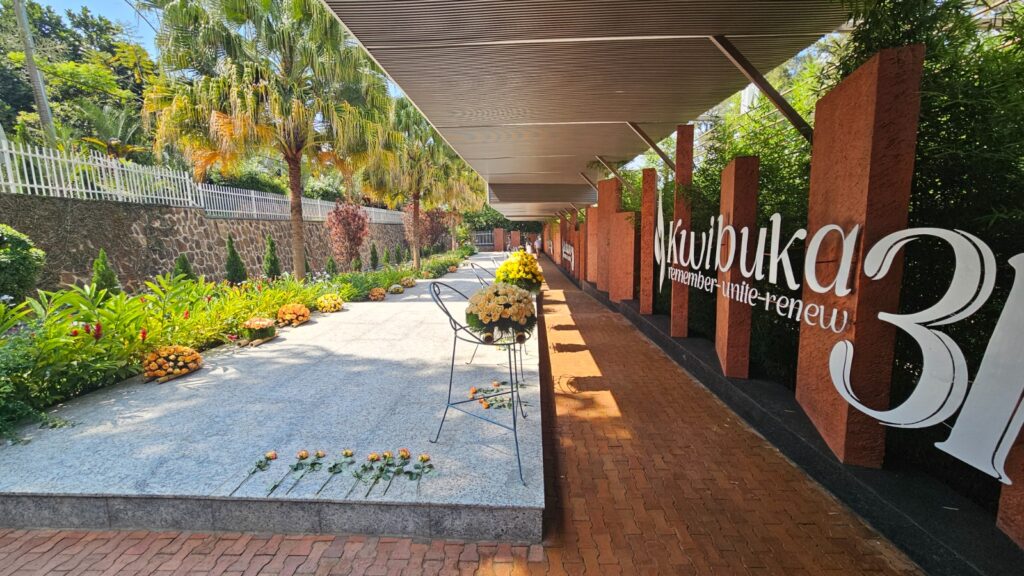
🏞️ The Kigali Genocide Memorial is located on a peaceful hill in Gisozi, just outside central Kigali. It stands solemnly over mass graves holding the remains of more than 250,000 victims of the 1994 Genocide against the Tutsi.
🕊️ Inaugurated in 2004 through a partnership between the Rwandan government and the Aegis Trust, the memorial offers a powerful mix of remembrance and education.
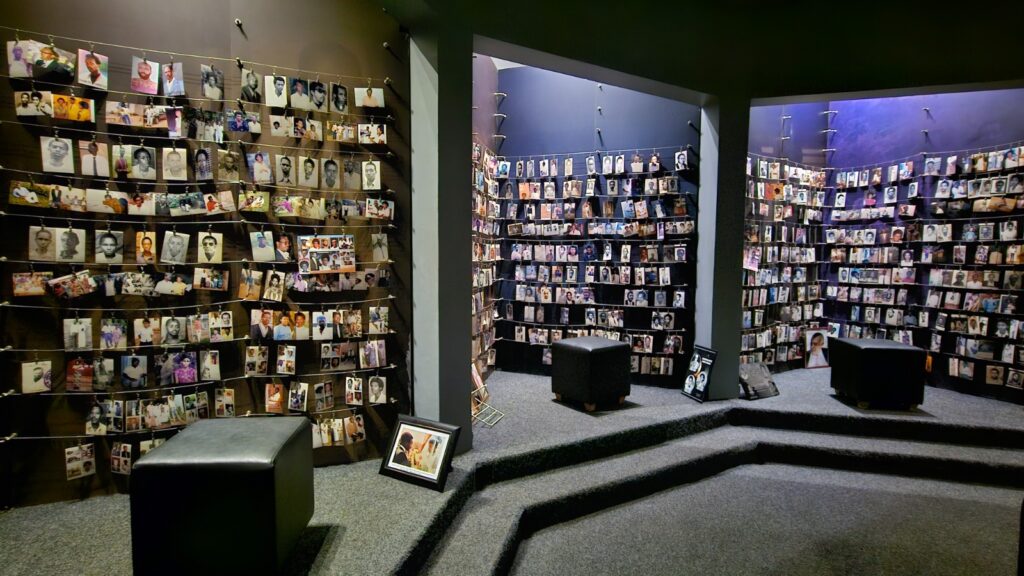
🎧 Entrance is free, but we chose to support the cause by renting an audioguide and buying a pin engraved with the word “Ubumuntu”, meaning humanity—representing goodness, generosity, and kindness.
💔 I was deeply moved by the museum’s honest and thorough documentation of Rwanda’s history, the genocide’s tragic unfolding, and the nation’s ongoing path toward justice and reconciliation.
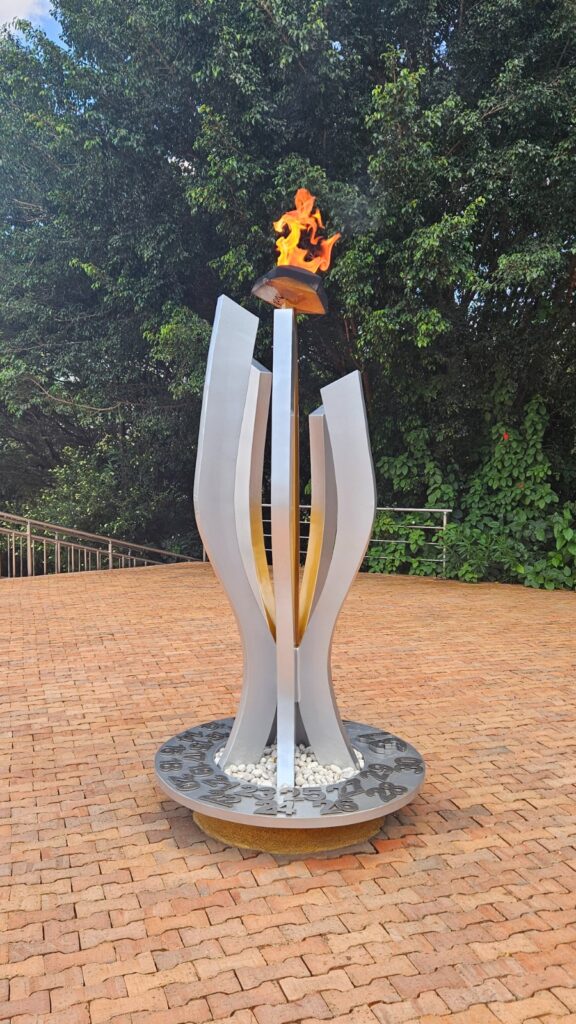
Some parts will stay with me forever—like the children’s memorial, featuring life-sized photos and personal stories, and the international context gallery, which connects Rwanda’s tragedy to other genocides worldwide, driving home the universal message: “Never again.”
🏃♀️ The Race 🏃♂️
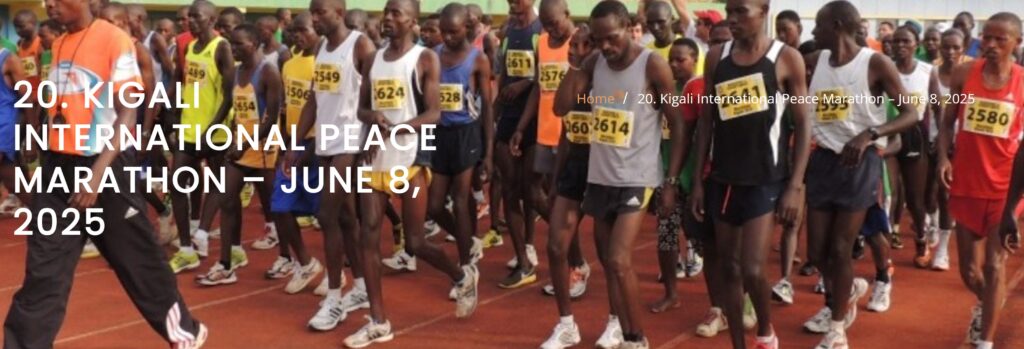
🏃♀️ From Half Marathon Dreams to a 10K Challenge
Originally, we planned to run the Kigali Half Marathon, but after major surgery at the end of January, signing up just two weeks later meant the half marathon wasn’t an option anymore.
So, I registered us for the 10K and kept my fingers crossed that we’d be able to finish it! 🤞
📝 Before the Race: Signing Up
The signup process for the Kigali Marathon was super straightforward—just a simple form with the option to pay via PayPal. The fee was $29 USD for all race categories for foreigners living outside Rwanda.
Residents had much cheaper prices, understandably.
🎽 Race Kit Pickup
The website was clear: no pickups on race day (Sunday). Since we were arriving from Bujumbura around 5:30 pm, I emailed the organizers in advance to let them know we might be late.
Their reply was warm and reassuring:
“Hallo dear Marta, we will make sure that you be served. We will arrange a special desk for late hours distribution (only and mainly for the Run for Peace runners).”
Thank you, organization! 👍
✈️ As luck would have it, our RwandAir Helix plane actually arrived early—before 5 pm—so we got to Amohoro Stadium with plenty of time to spare.
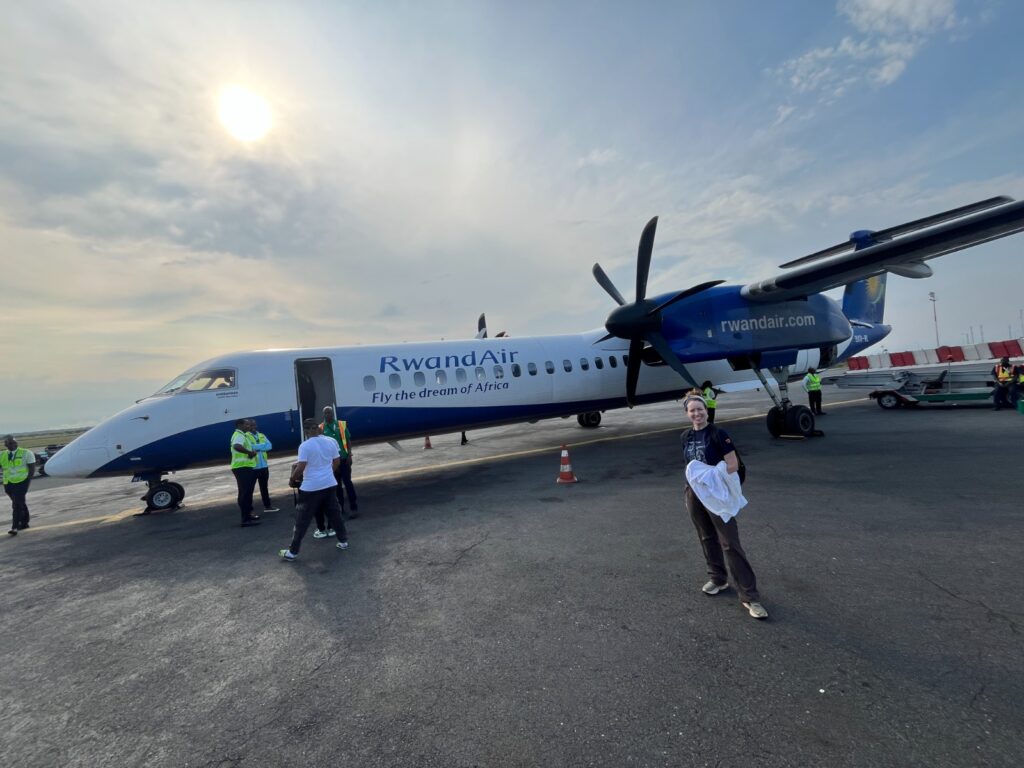
🚨 Marathon Fair — Security First!
We arrived at the marathon fair inside the monumental Amohoro Stadium by car—and the security was serious.
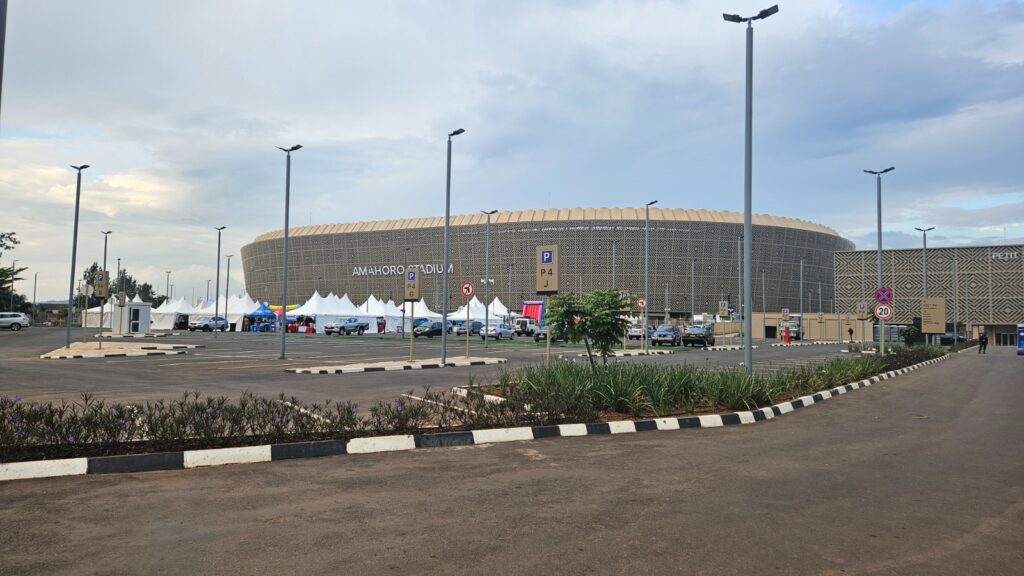
🚨 Our Uganda guide, Leticia, warned us as we entered Rwanda:
“This is the land of security!”
And she wasn’t kidding. Rwanda takes security seriously. The airport was the perfect example — multiple body scans and baggage checks. Even at the hotel, our car was searched for bombs.
So, naturally, when we arrived at the marathon fair, our car, bags, and ourselves were thoroughly searched by police officers before entry.
🏟️ The Start and Finish — Amohoro Stadium!
The marathon fair, start, and finish were all at the same spot, making logistics a breeze.
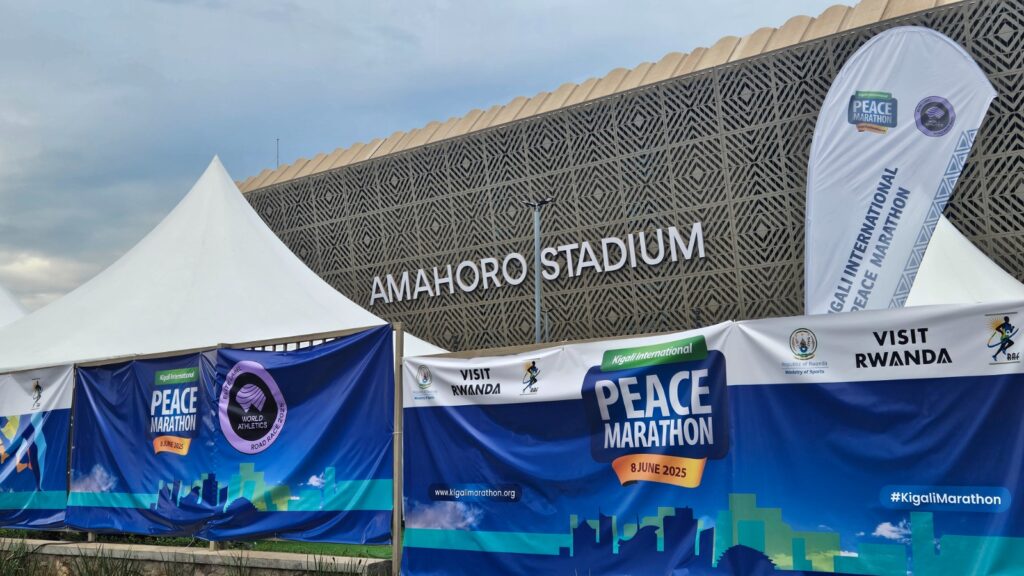
And having it at Amahoro Stadium (officially Amahoro National Stadium) was a major bonus!
This is Kigali’s premier sports venue, originally opened in 1986. During the 1994 genocide, the stadium briefly served as a UN-protected refuge for thousands of people.
From 2022 to 2024, it underwent a $165 million renovation — and it definitely showed when we visited. The stadium looked stunning! ✨
The upgraded stadium was officially inaugurated on July 1, 2024, by President Kagame and CAF President Patrice Motsepe.
🌧️ Land of a Thousand Collins and Thousand Rain Showers?
When we picked up our race kits, the weather was cloudy and wet — it had been raining earlier. We weren’t sure if rain would greet us on race day, but honestly, running in the rain felt better than scorching sun!
🎽 The marathon fair was bigger than I expected, with plenty of stalls offering and promoting sports gear and products — definitely had the feel of a true international marathon.
🎟️ Picking Up the BIBs
The registration office was located in the “Paralympic complex,” a well-organized spot to get everything sorted.
There were many desks for the “Run for Peace”, the 10k race we were running. Not so many for the Half Marathon and even less for the Full Marathon, which gave us an idea of how many runners each race would have. There were no queues and everything went smoothly.

We gave our names, explained that we had paid via Paypal, and they gave us our BIBs.
No t-shirt, though… 😭

Since the “Run for Peace” was not cheap (77 EUR), I was expecting one…
🌅 Race Day
We woke up to a stunning sunrise over Kigali, right from our room at the Hôtel des Mille Collines — a perfect way to start the day! 🥰
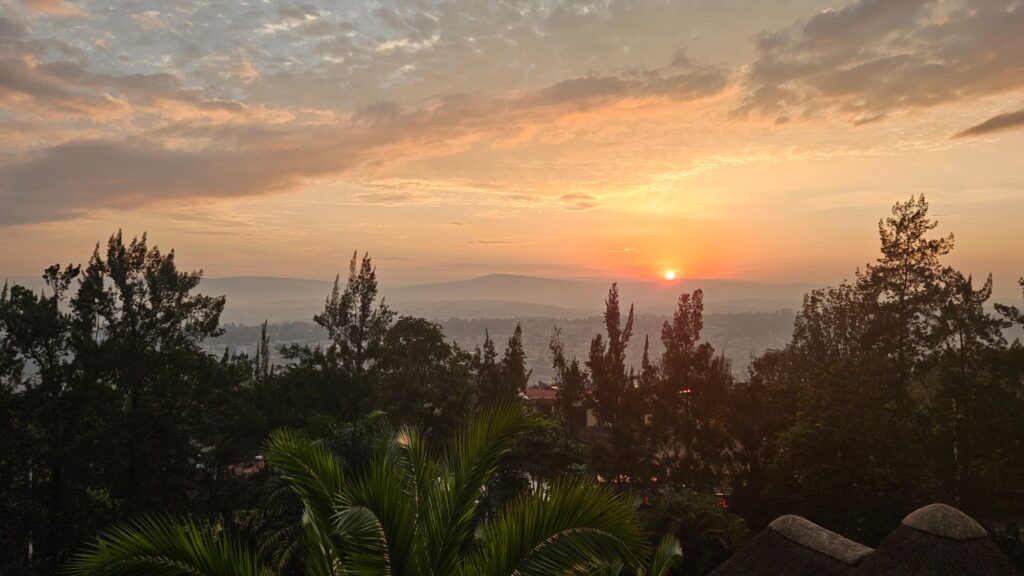
Would the race be just as amazing? We hoped so.
🌡️ The temperature was cool, and the sky looked cloudy, but just in case, I put on some sun cream. Smart move! The sun did peek out occasionally — and being in Africa near the Equator, the sun’s rays are no joke. ☀️🧴
⚠️ Word of Caution:
What we didn’t realize was that Kigali sits pretty high — about 1,567 meters (5,141 feet) above sea level.
Plus, the course was full of ups and downs — no surprise in the “land of a thousand hills”! So, don’t expect a personal best (PB) here! ⛰️🏃♂️
🚗 Getting There Was an Adventure
Given Rwanda’s intense security, we figured the roads around the racecourse might be closed to traffic.
But we didn’t plan well and ended up driving our taxi driver a little crazy! 😂
We spent about half an hour circling around, trying to reach Remera — the neighborhood where Amohoro Stadium is located.
On the bright side, it gave us a cool chance to take in some of Kigali’s city vibes. 🌆
We passed by rich-looking suburbs and I loved the slogans painted on the walls in the “Precious Stones Foundation”, which were meant to inspire kids.
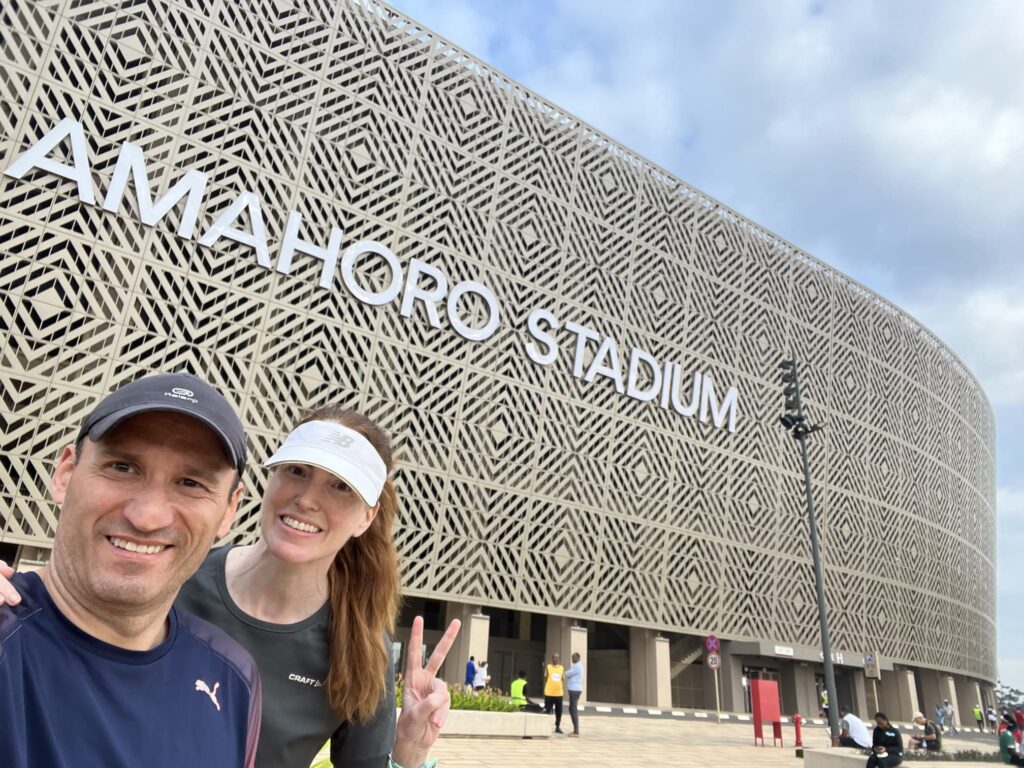
🏃♀️ Kigali’s Sports Culture Inspired Me!
Everywhere we looked, there were runners—organized groups with coaches, fitness instructors, and lots of energy in the air!
For the first time, I even spotted a cyclist decked out head-to-toe in full technical gear 🚴♂️ — and a man rocking a bright pink short-sleeved shirt! Wow, what a bold fashion statement! 💖🔥
🚶♂️ We asked our driver to drop us near the stadium, then walked about 1 km to the venue. Of course, before entering, we went through strict security checkpoints — all part of the Kigali experience!
🎉 Before the Race
The atmosphere was buzzing and truly international: a group of Germans sporting “Team Germany” shirts 🇩🇪, a lively, loud Kenyan squad waving their flag 🇰🇪, and an even louder Tanzanian crew! 🇹🇿
Some groups were warming up to music — and guess what? They played hits like Shakira’s “Waka Waka” and Avicii’s “Wake Me Up” just like in Uganda. I loved it! 🎶💃
🚻 Facilities were good, with plenty of toilets, but things felt a bit chaotic. We were told the race would start at 8:00 am — but at 8:10, no one was near the start line yet.
Later, watching the awards ceremony on TV, we learned the full marathon had already started at 7:00 am! ⏰🏅
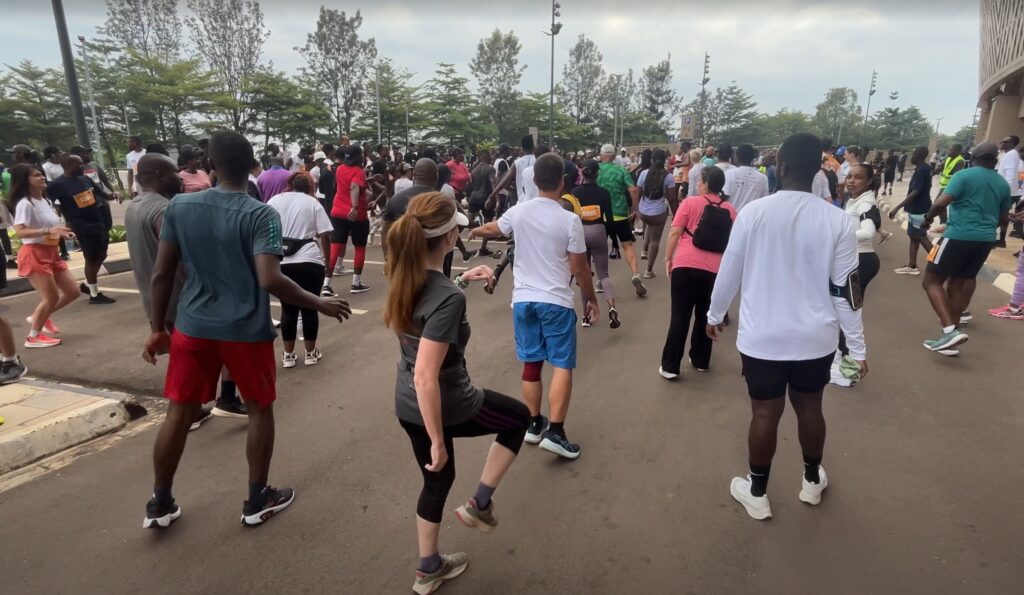
🏁 Finally, the Race for Peace Begins!
At 8:05, a voice over the speakers called the Half Marathon runners to the Start Line. We followed… but were told:
❌ “Nope! The Race for Peace starts on the opposite side of the stadium.”
😵💫 Quite chaotic, to be honest.
🔍 Where is the “Run for Peace” Start?
We circled around the stadium and, sure enough, found another Start Line — with loud music, people stretching, and the occasional full marathoner passing by. At the time, we didn’t realize it… but they had already been running for over 90 minutes! 😮💨🏃♂️
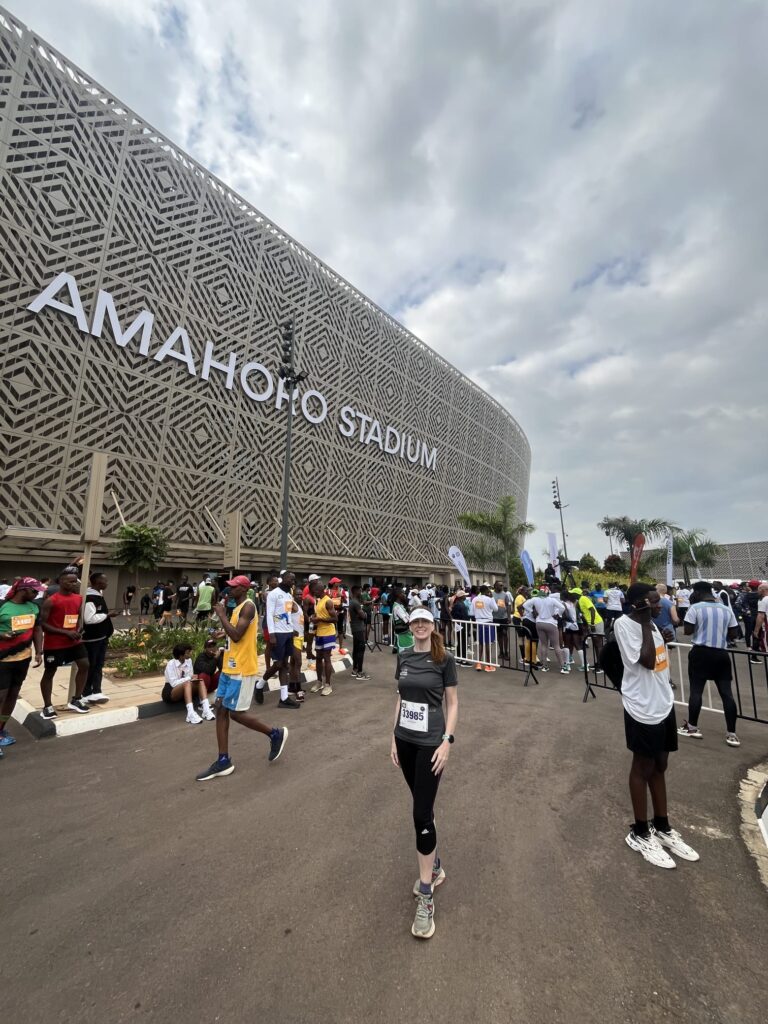
Suddenly, out of nowhere, hundreds of runners came flooding toward the Start Line — from the opposite direction! To this day, I still have no clue where they came from 😂🤷
No time to figure it out — we all got into place and…
🎽 The Start
There was no official countdown, no announcement… people just started running! 🏃♀️💨
One thing that did make the start special was a phenomenal group of traditional drummers 🥁 dressed in immaculate white — full of rhythm and energy! (We later saw them featured on TV 📺)
We were so caught up in the moment that we only turned on our Garmins after a few hundred meters 😅
And then — surprise! — a handful of full marathon runners came toward us from the opposite direction… I couldn’t believe it! It was a zigzag of distances and directions. Welcome to Kigali 🇷🇼✨

Poor guys. Running against hundreds of people!
🏃♀️ The First Kilometers
The first few kilometers were downhill — smooth, calm, and just perfect.
✅ Ideal temperature
✅ Gentle pace
✅ No pressure — just enjoying the moment.
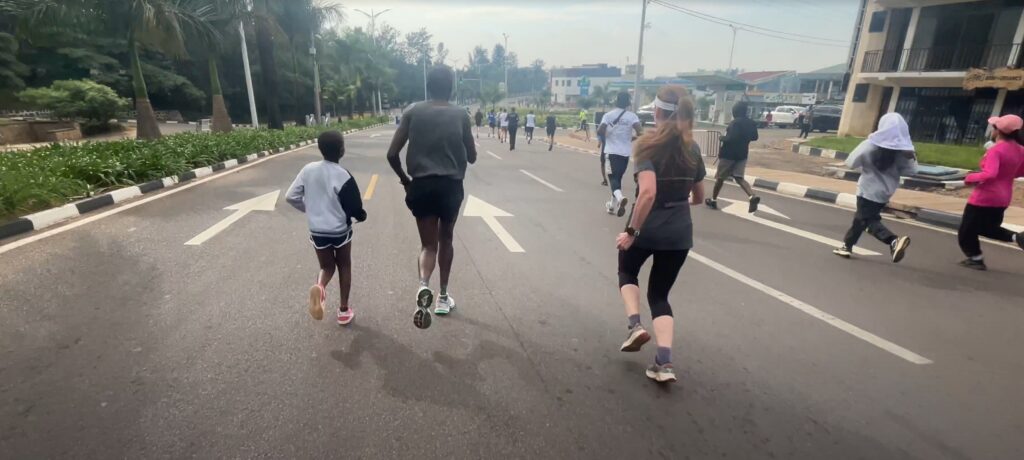
We were being cautious and took it very easy, especially since I’m still recovering from surgery. Grateful just to be running 💪🌅
At kilometer 2, volunteers handed us bottles of water 💧 — super appreciated! The hydration points were well placed and efficient.
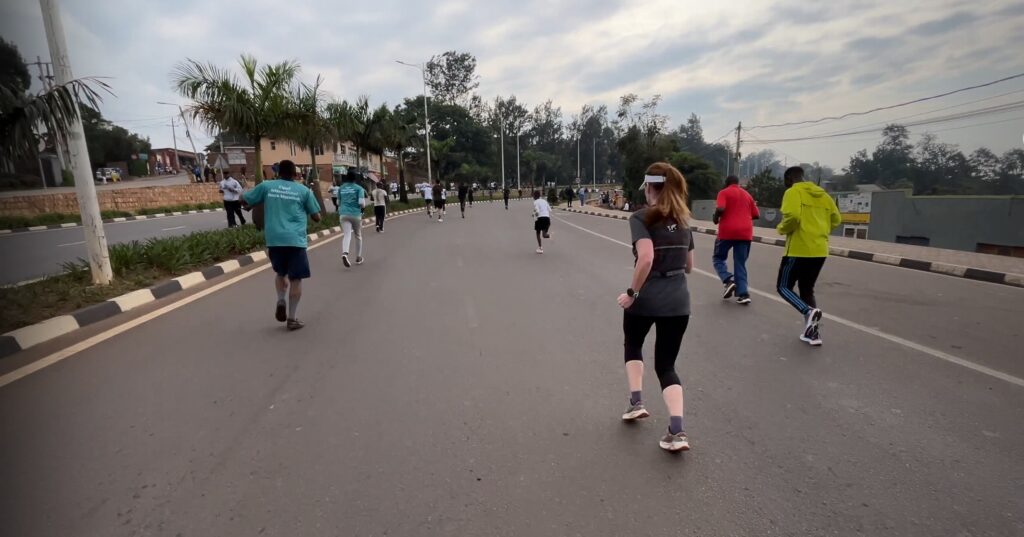
We cruised along a wide avenue, with beautiful views of Kigali in the background 🏙️.
Later on, we’d loop back the same way — and from our lane, we could already see the faster runners flying through kilometer 5 a few meters below us. Impressive!
👟 Mid-Race Moments
What surprised me most?
Some kids were running with us — and not just tagging along — actually keeping pace at a remarkable speed! 🧒🔥
We ran alongside one particularly young boy for several kilometers. He seemed completely unfazed — never slowing down, never out of breath. A natural talent! 🌟
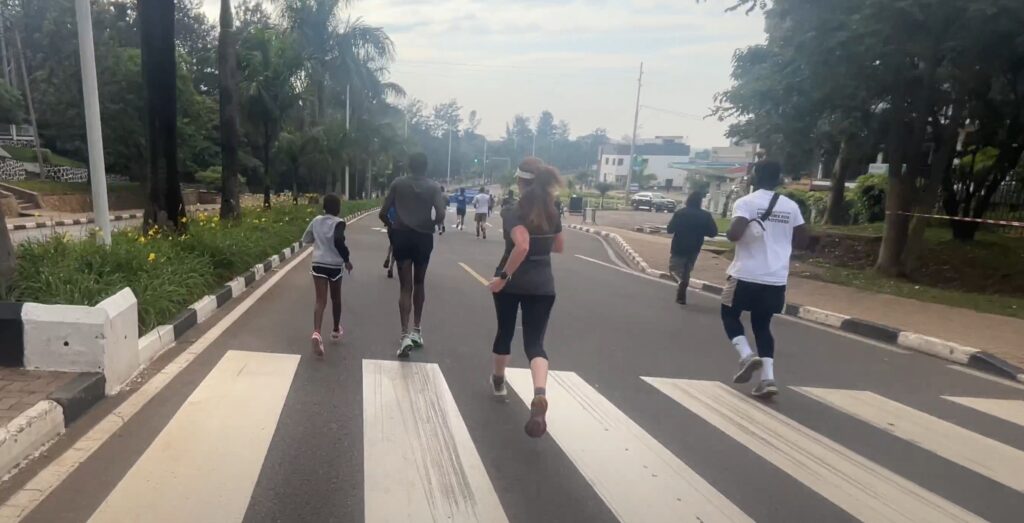
It was one of those moments where the energy of the crowd, the joy of the run, and the uniqueness of Kigali all came together. 💛🇷🇼
🏃♀️ Kilometer 5: A Bit of Magic
At kilometer 5, I had one of those “I love being here” moments.
Some loudspeakers were blasting “The Summer Is Magic” by Playahitty (very 90s, very loud 😄), the sun was shining, a crowd of smiling locals lined the road, and I was running side by side with a local kid.
It was magic. Pure and simple ✨💛🇷🇼
⛰️ Up We Go!
After completing the second leg of the avenue, we turned right and… uphill we went!
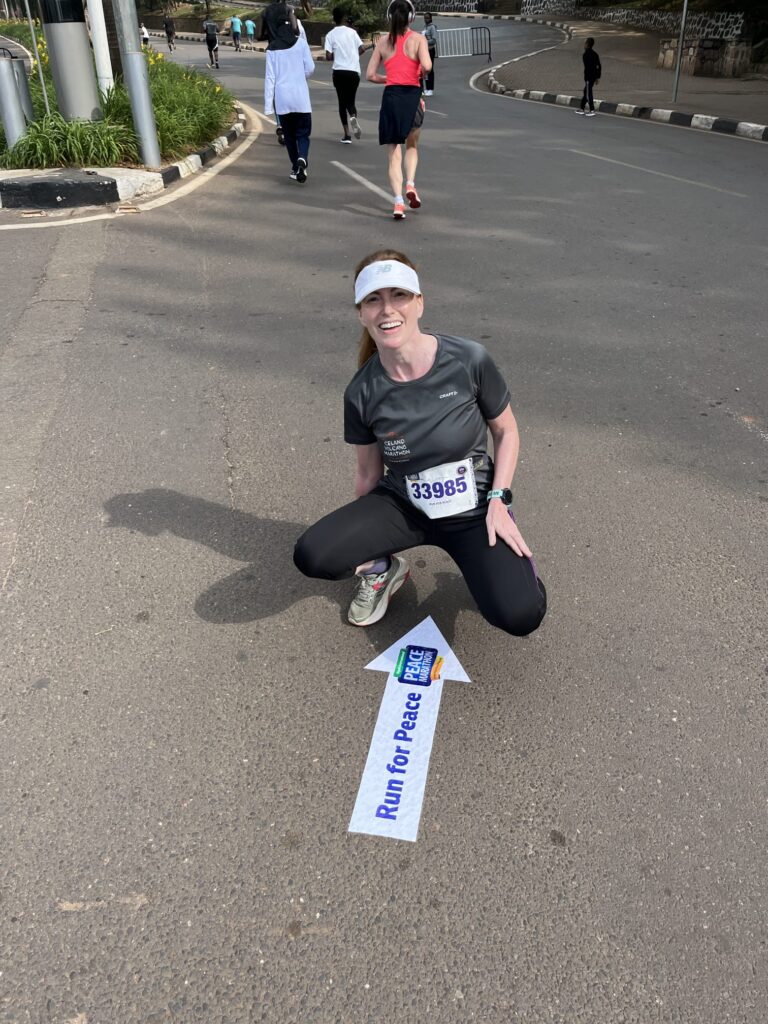
The incline wasn’t brutal — or maybe we were just well trained enough — but you could tell we were getting closer to the stadium.
We kept running at a comfortable pace, playing it safe and soaking it all in.

❓Last Kilometers — Where’s the Finish?!
As we circled the stadium during the final stretch, we started overtaking runners who were struggling with the hills. We felt strong and ready. At kilometer 10, we knew we were near the end!
There was a sign: “Run for Peace turn left” — but a marshal waved us on, telling us to keep going straight. So… we did. Along with all the runners around us.
Then, a couple hundred meters ahead… another marshal told us to turn back!
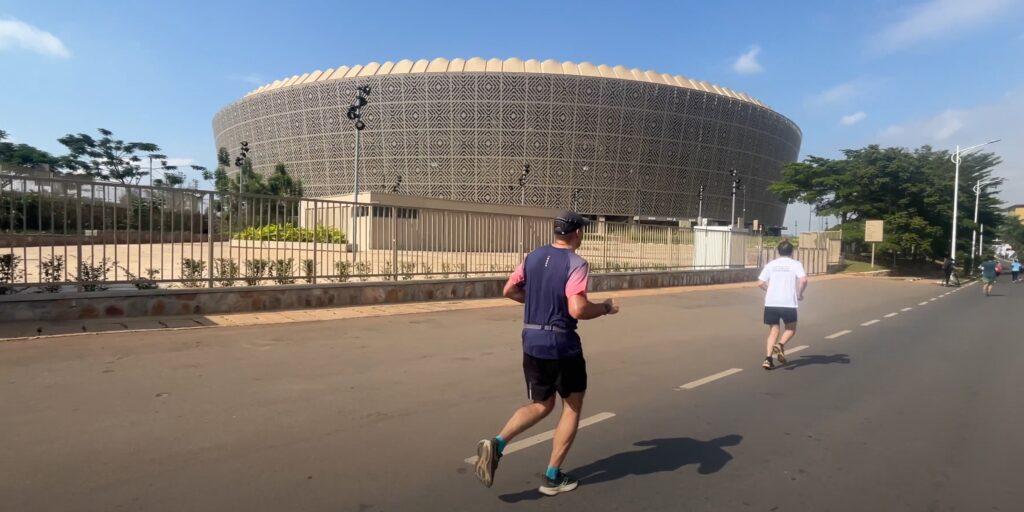
What a mess 😤. I actually shouted a loud, frustrated “WTF?!”
It felt like we were running a bonus lap we didn’t sign up for.
We turned around, warned the oncoming runners not to repeat our mistake, and finally followed the sign to the correct “Finish Line.”
And there it was… 🎉
We crossed the finish line holding hands, sweaty, happy, and laughing. What an ending!

😂 Wait… That Was the Half Marathon Finish?!
The funny thing was… the finish line we triumphantly crossed?
It was actually the Half Marathon finish!
Apparently, the “Run for Peace” finish was somewhere on the side of the stadium — but it wasn’t marked, and most of us got lost. 😣
So we just kept running until we hit some finish line!
🏅 Post-Race Vibes
After the race, we were given as many water bottles as we wanted and these curious things called “glucose biscuits”.
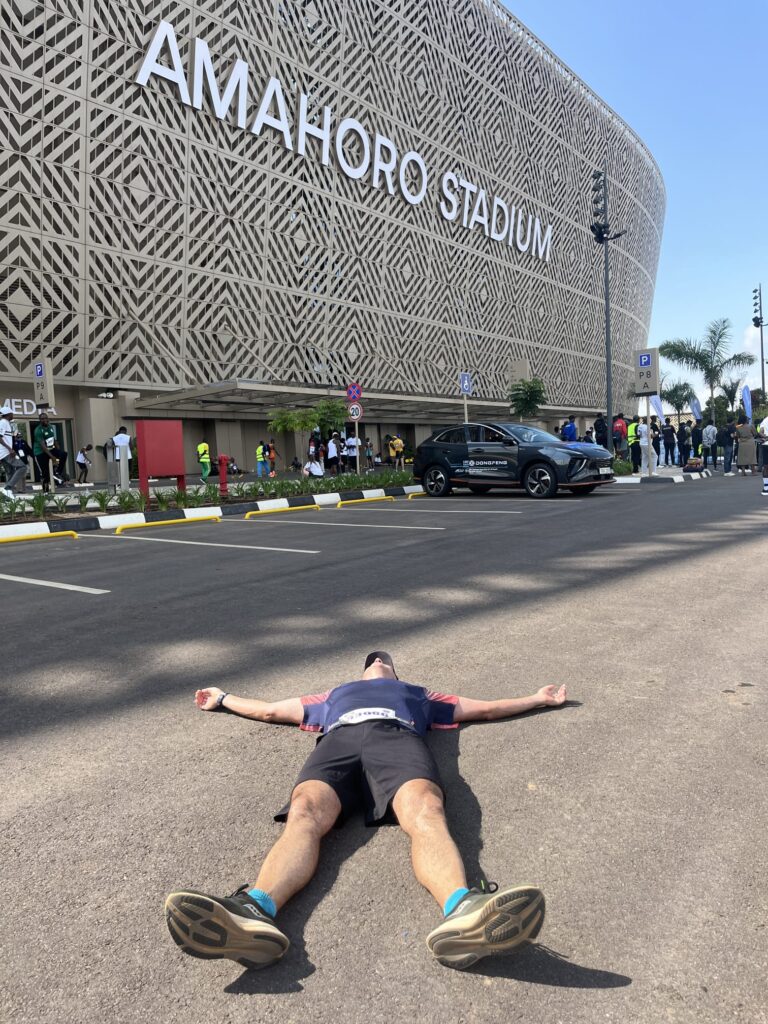
(Also in Uganda, all biscuits were proudly branded as “glucose biscuits” — I had never seen that before. Apparently glucose gives you superhero powers 🦸♀️💥).
Then we headed over to collect our medals, as the speaker announced enthusiastically:
“Run for Peace runners, please go and get your well-earned medals!”
We received them in their protective sleeves — which we gladly kept to store them safely in our luggage 👍. Small victories!
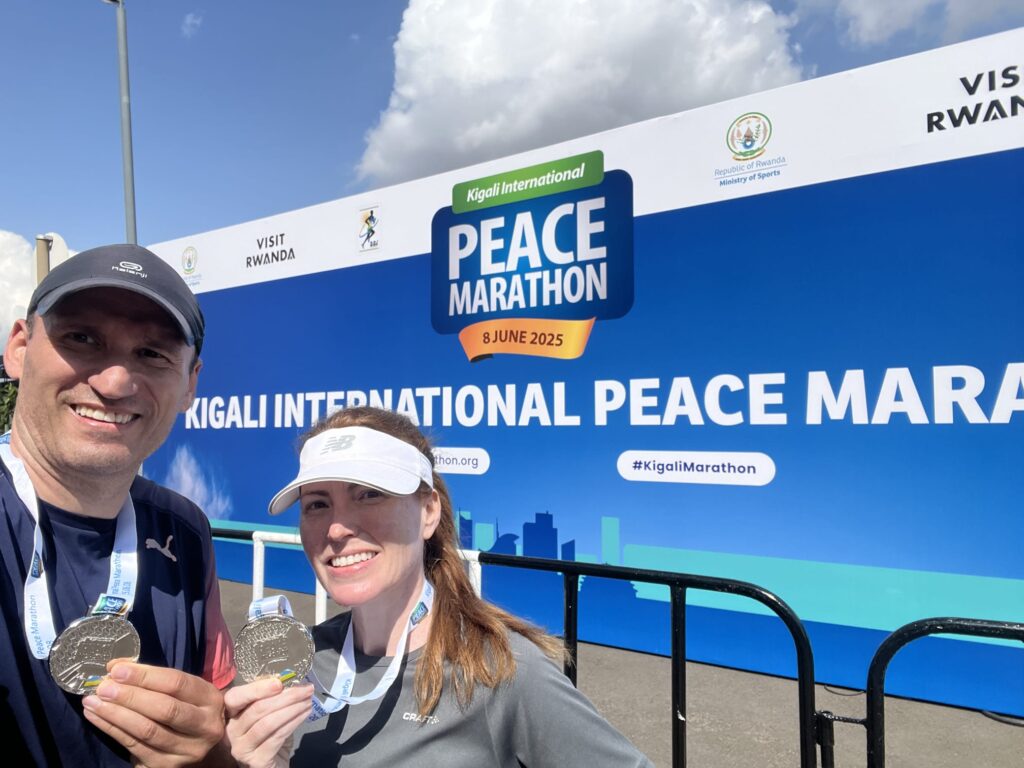
🌀 Where’s Our Driver?!
We then spent a solid hour trying to find our driver, but thankfully we weren’t too tired, so it turned into a funny post-race quest.
And during that time, we saw some truly unexpected Kigali moments:
Like three young guys dressed like Coolio in “Gangsta’s Paradise”… carrying dead chickens, holding them by the legs.
No bags, no boxes — just swagger and poultry 😲🐓🎧
🚗 Hotel Bound – Finally!
The traffic in a few nearby streets reopened just as our driver finally found us — talk about timing!
So, after our scenic post-race wandering and chicken-spotting detour, we managed to get back to our hotel not too late, still buzzing from the morning’s experience.
📺 Live on Rwandan TV – The Awards Ceremony!
Back in our room, we kicked off our shoes, grabbed breakfast, and turned on the TV…
And there it was: the awards ceremony, live on Rwandan national television!
The TV host was seriously pumped, declaring that the winners were “taking home a whooping 5,000 USD!”
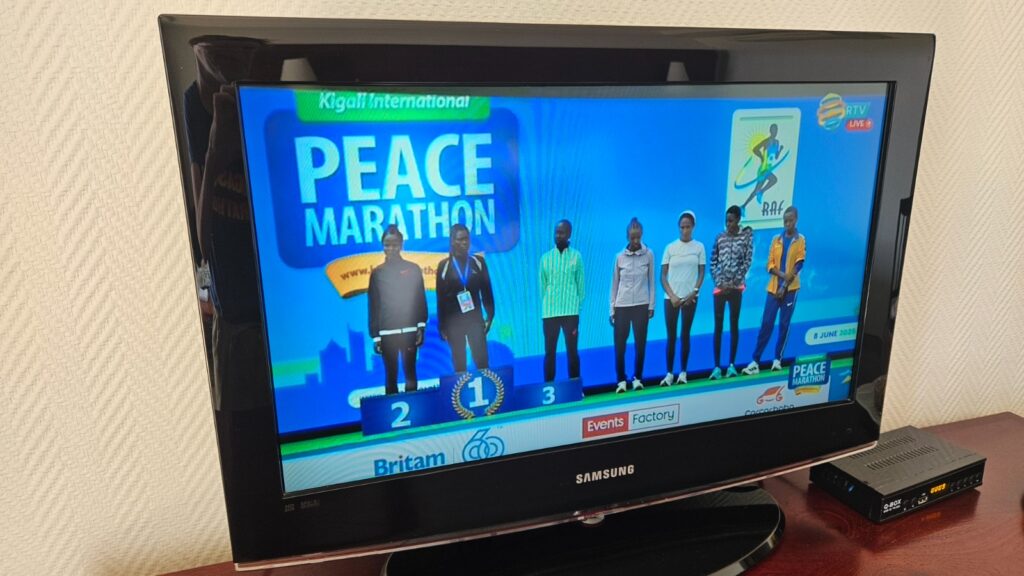
🏃♂️🏃♀️ As expected, most winners were from Kenya, and they played the full national anthem for each winner — both male and female, for the marathon and the half marathon.
Which means… yes, I sat there, munching on my croissant, listening to the Kenyan national anthem four times in a row. 🇰🇪😂
By the end, I could almost sing along!
🍜 Carboloading 🍝: What to eat in Rwanda if you are a runner
We enjoyed Rwandan food a lot, mainly because of its fresh ingredients 🥬🍅.
Also, we were fortunate enough to have a good chef 👨🍳 at our lodge, who cooked really well but didn’t create dishes that were massive (like in Uganda! 🇺🇬). We ate avocado salads 🥑, tomato 🍅 and pumpkin 🎃 and gingerbread soups, beef stew 🥩, roasted chicken 🍗… and you could truly taste the freshness of the ingredients.
And here, like in Uganda, “Spanish omelette” is different from what we understand in Spain 🇪🇸. No potatoes! 🥔🚫 (Even if there were many potato fields surrounding our lodge! 🌾)
☕ African Tea!
Plus, I pursued my recently acquired taste for “African tea” (which I had developed in Uganda) and enjoyed a few cups of the delicious spiced black tea with milk 🫖🥛.
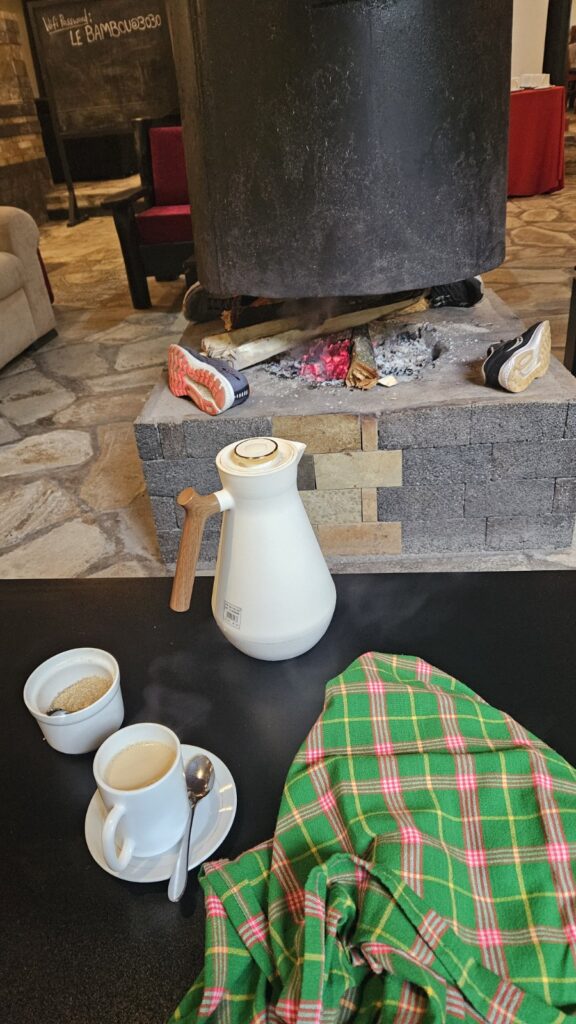
Here’s a picture of me writing like a “pro” with my cup of African tea and even a blanket! While outside it was wet and rainy… 🥶
🏃♂️ What to Eat in Rwanda Before a Long Run
Before a long run like a marathon in Rwanda, it’s important to focus on carbohydrate-rich foods 🍚 that provide sustained energy. Rwandan cuisine offers many excellent options that are natural, wholesome, and easy to digest, ensuring you fuel your body without feeling weighed down. 💪
A great pre-run meal could include ugali 🍛, a staple dish made from maize or cassava flour. Ugali is an excellent source of complex carbohydrates, offering slow-releasing energy to power you through long distances. Pair it with a mild vegetable stew 🥬 or boiled greens like isombe (cassava leaves) for added vitamins and minerals.
Another great choice is sweet potatoes 🍠, which are commonly grown in Rwanda. They are rich in complex carbohydrates, potassium, and vitamin C, making them a perfect option for both energy and hydration.
For something lighter and quicker to digest, consider plantains 🍌 or bananas. They’re rich in simple carbohydrates that provide a quick energy boost ⚡. Eating these with a small handful of groundnuts 🥜 (peanuts) adds healthy fats and protein for a more balanced meal.
Don’t forget to hydrate 💧 with plenty of water or natural options like coconut water 🥥, which helps replenish electrolytes before the race.
🏁 What to Eat in Rwanda After a Long Run
After a marathon, your body needs a mix of protein and carbohydrates to aid recovery, rebuild muscles, and replenish glycogen stores 🔋. In Rwanda, traditional dishes make it easy to create a nutrient-packed recovery meal 🍽️.
Start with ibihaza 🎃, a dish made from boiled or roasted pumpkin. Pumpkin is a good source of carbohydrates for restoring energy, and it’s easy on the stomach after intense exercise. Pair it with beans or a bean stew 🫘, which are staples in Rwandan cuisine and an excellent source of plant-based protein to help repair muscle tissue.
Adding a small serving of avocado 🥑, another Rwandan favorite, provides healthy fats and potassium, aiding in hydration and reducing inflammation.
For those who prefer animal protein, brochettes 🍢 (grilled meat skewers) made from goat, chicken, or fish 🐐🐔🐟 are a great option. Pair them with irish potatoes 🥔 or rice 🍚, which are high in carbs and widely available in Rwanda.
As a snack, consider milk and bananas 🥛🍌, a classic Rwandan combination. Milk provides protein and calcium for recovery, while bananas replenish lost potassium and provide quick energy.
Finally, ensure you rehydrate thoroughly 💦 after the race. Fresh passion fruit juice 🥭 or sugarcane juice 🍹 can be great options, as they provide natural sugars, vitamins, and hydration.
Combining these traditional Rwandan staples ensures your body is replenished, restored, and ready for your next run! 🏃♀️🔥

Useful information
🏆 Kigali International Peace Marathon – Marathon (42k), Half Marathon (21k) and the “Run for peace”, 10k.
🌐 Website: https://kigalimarathon.org/
🏃 Number of runners: Around 2000 split in all categories. Fast growing!
🗓️ Beginning of June in Kigali, Ruanda, Africa.
👟 Urban: bring shoes for asphalt.
✅ Quite well organised compared to other races in Africa, although a few mistakes made us laugh (and shed tears of despair!)
✅ Hilly but manageable, so ideal for training and pushing yourself to the limit!
⚠️ The hills, again. It is not a race to do a PB.
⚠️ Do not run the marathon unless you are fast, or you will have thousands of runners of the “run for peace” running towards you in the opposite direction!!!

Map
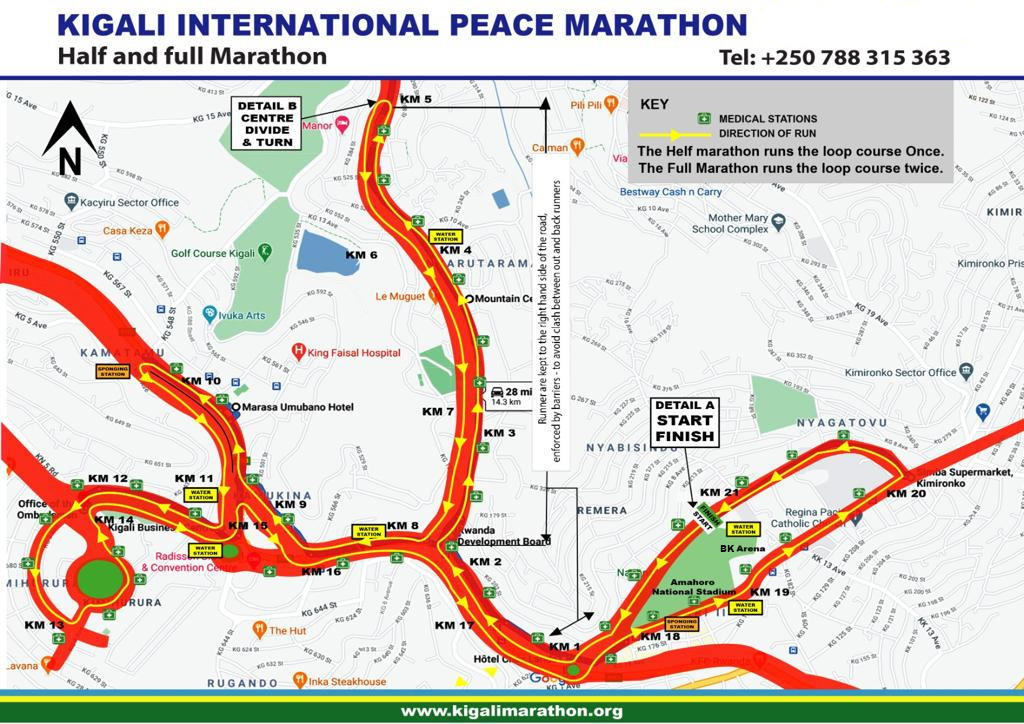
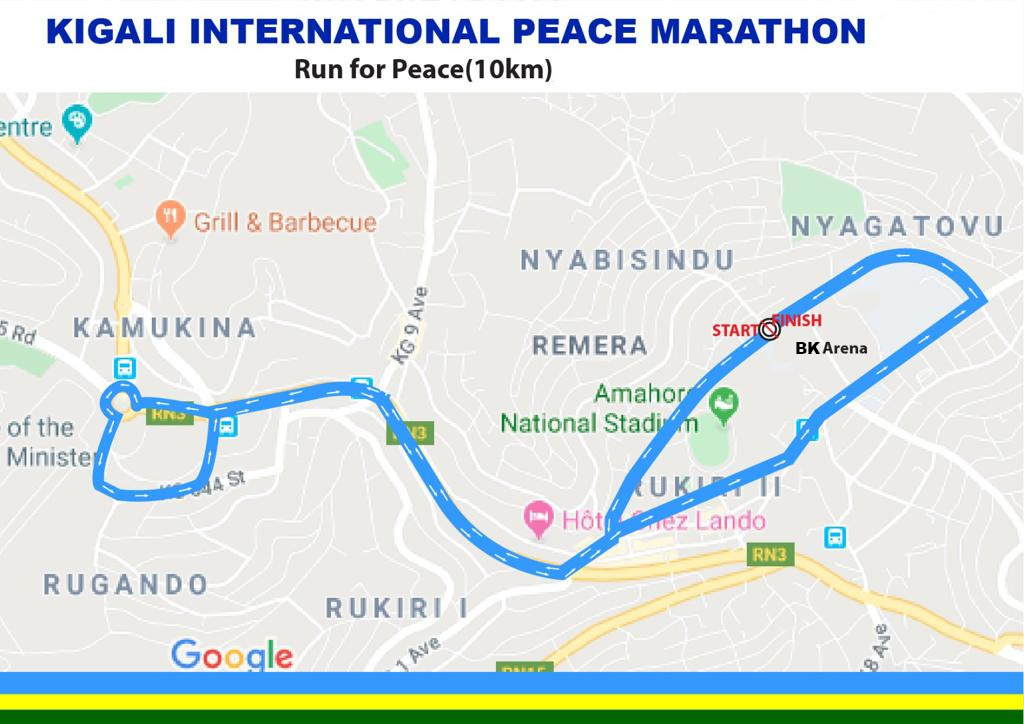
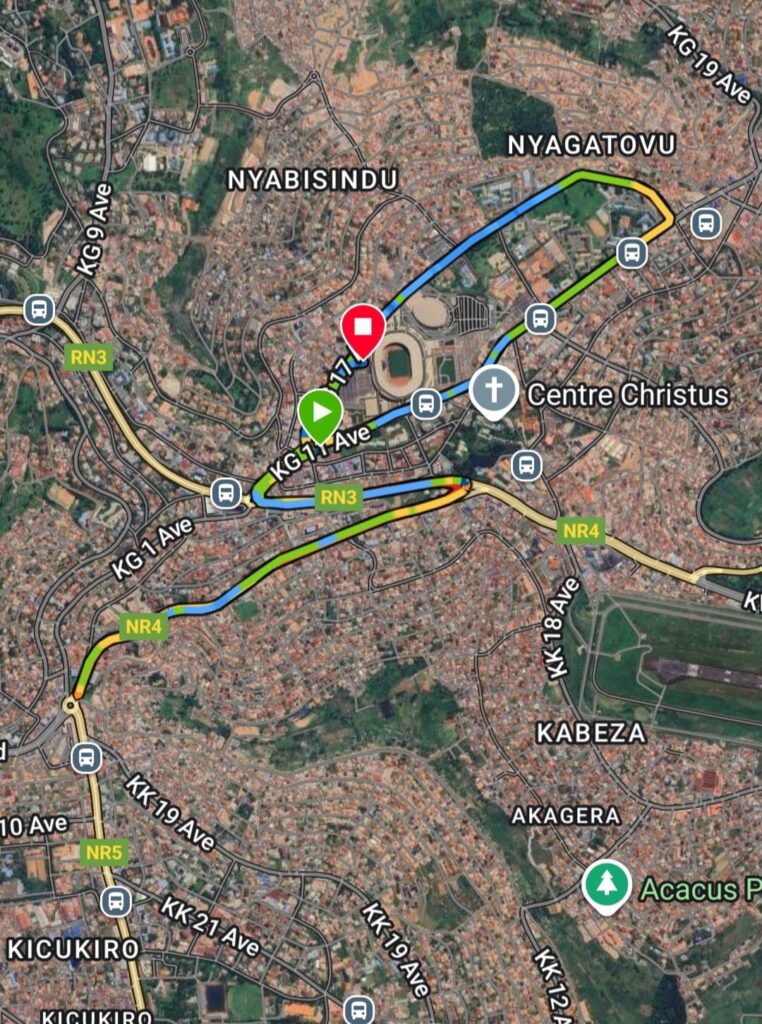
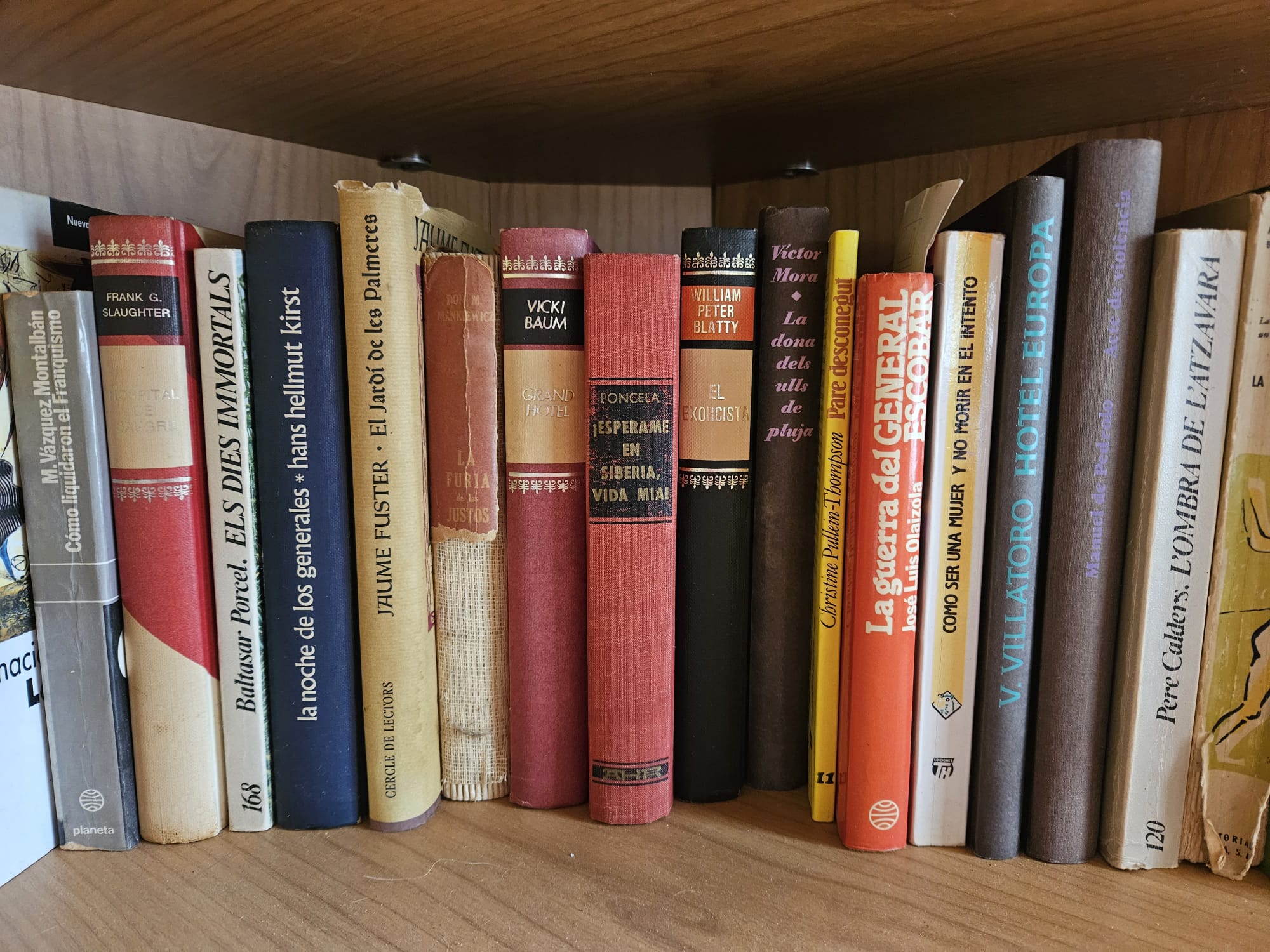
One book
“Our lady of the Nile”, by Scholastique Mukasonga
📖 Reading Our Lady of the Nile
Reading Our Lady of the Nile by Scholastique Mukasonga was a deeply enriching experience—one of those rare books that stays with you, both emotionally and intellectually. It blends beautiful, poetic prose with sharp historical insight, touching on universal themes of identity, prejudice, and power.
Set in the 1970s, the novel gives a haunting glimpse into the social undercurrents that would eventually erupt into the 1994 Genocide against the Tutsi. Through the seemingly insulated world of an elite Catholic girls’ boarding school, Mukasonga shows how dangerous ideologies can quietly seep into daily life. The school becomes a microcosm of Rwanda—where tensions simmer, and where casual words and institutional bias foreshadow national tragedy. ⚖️📚
But the novel is also a coming-of-age story, full of teenage girls navigating friendship, ambition, faith, and identity within a rigid and stratified system. Their experiences, although rooted in a specific time and place, resonate universally. It’s this dual lens—personal and political—that makes the novel so powerful. 👭🌍
Mukasonga’s writing is lyrical, grounded, and evocative. Her descriptions of Rwanda’s landscapes—the hills, the rain, the ever-present red soil—immerse you completely. And her portrayal of unease, of that growing sense that something is very wrong, is masterful in its subtlety. 🌧️🌿
🔥 By the fire, Rwanda on the page and outside
At night, back in our lodge, we had a fire in our room (yes, an actual fireplace in Rwanda! 🥰🔥) and I just couldn’t stop turning the pages.
Reading about Rwanda in the book, then walking through Rwanda the next day, created an almost surreal feeling of continuity. Like this line I read:
“…passers-by on the road — in Rwanda there are always passers-by on the path, although you never know where they are coming from or going.” 🚶🏾♀️🚶🏽♂️
And then I would see them: on the red-dirt paths, quietly walking, appearing and disappearing into the green.
Or this:
“…for several months, rain becomes the Sovereign of Rwanda, a far greater ruler than the former King or the current President.” 👑🌧️
And sure enough, it rained again. Softly, then heavily, then softly again. Like a mood, or a presence. The rain in Rwanda really does feel sovereign.
This book gave me context, poetry, and a sense of closeness to the people and the land I was seeing each day. I can’t recommend it enough. 💛📖🌍
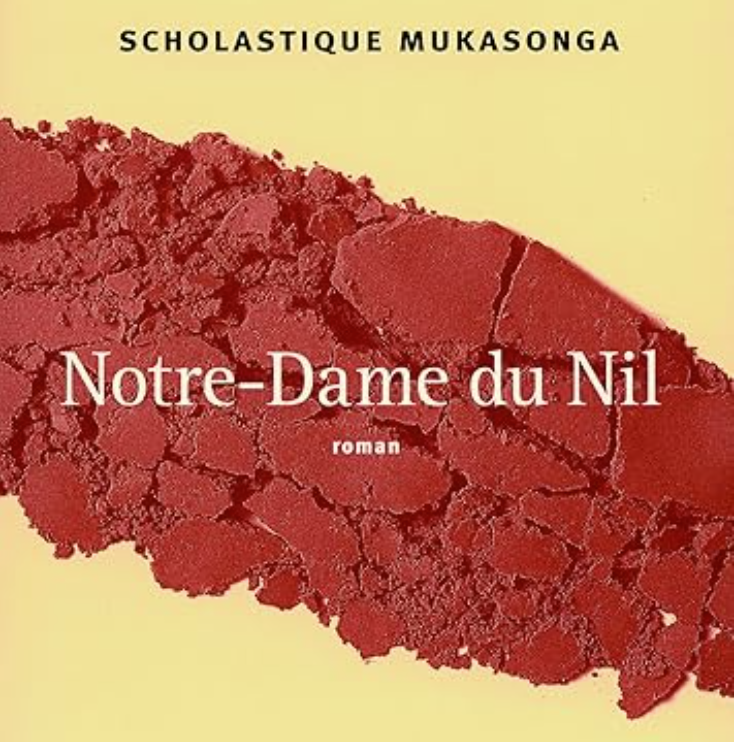
Plot Summary:
There is no better lycée than Our Lady of the Nile. Nor is there any higher. Twenty-five hundred metres, the white teachers proudly proclaim.’ Parents send their daughters to Our Lady of the Nile to be moulded into respectable citizens, and to protect them from the dangers of the outside world.
The young ladies are expected to learn, eat, and live together, presided over by the colonial white nuns. It is fifteen years prior to the 1994 Rwandan genocide and a quota permits only two Tutsi students for every twenty pupils.
As Gloriosa, the school’s Hutu queen bee, tries on her parents’ preconceptions and prejudices, Veronica and Virginia, both Tutsis, are determined to find a place for themselves and their history.
In the struggle for power and acceptance, the lycée is transformed into a microcosm of the country’s mounting racial tensions and violence. During the interminable rainy season, everything slowly unfolds behind the school’s closed doors: friendship, curiosity, fear, deceit, and persecution.
Our Lady of the Nile is a landmark novel about a country divided and a society hurtling towards horror. In gorgeous and devastating prose, Mukasonga captures the dreams, ambitions and prejudices of young women growing up as their country falls apart.
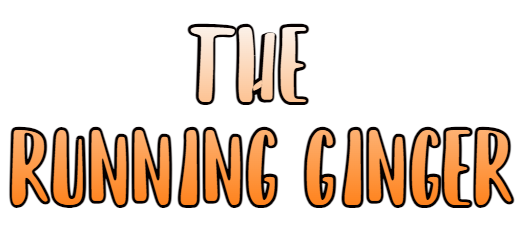

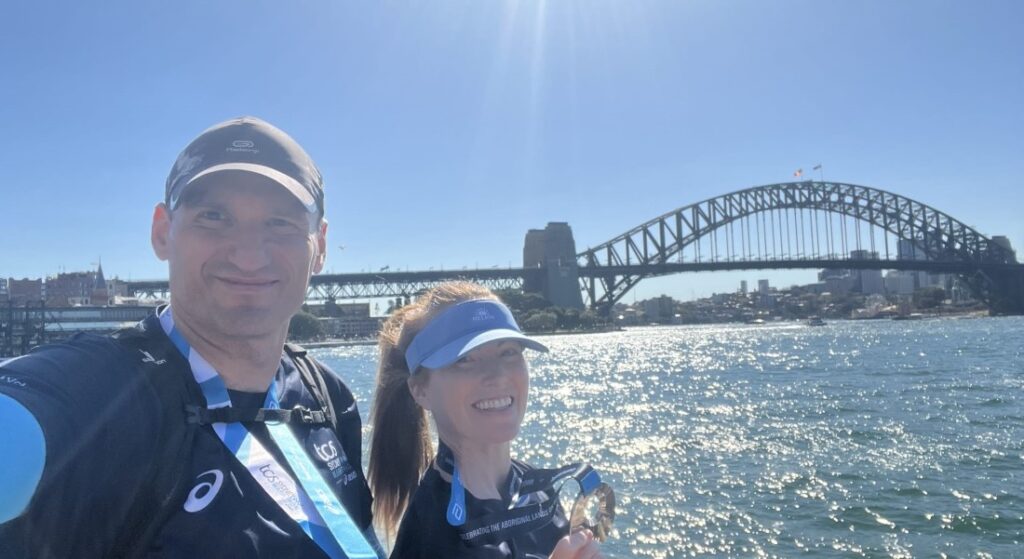
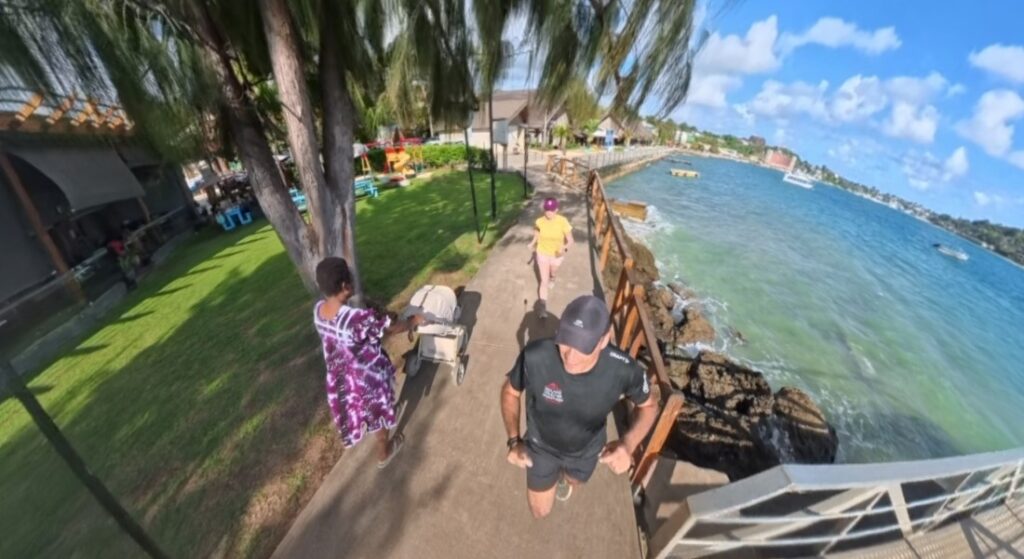
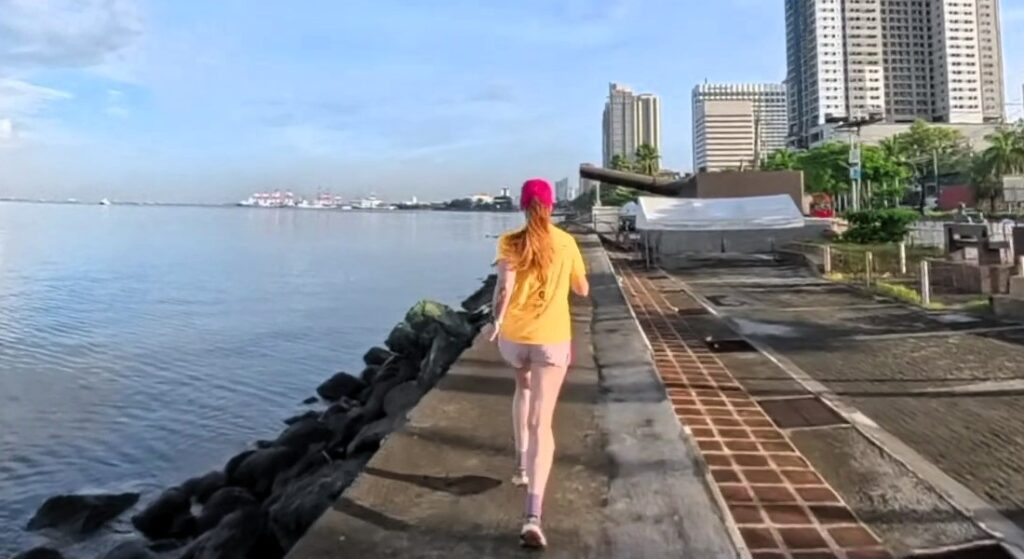
One Comment